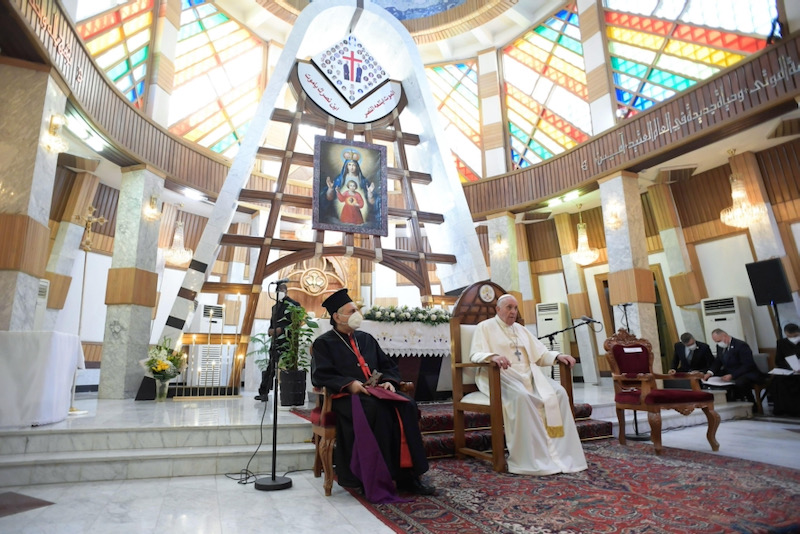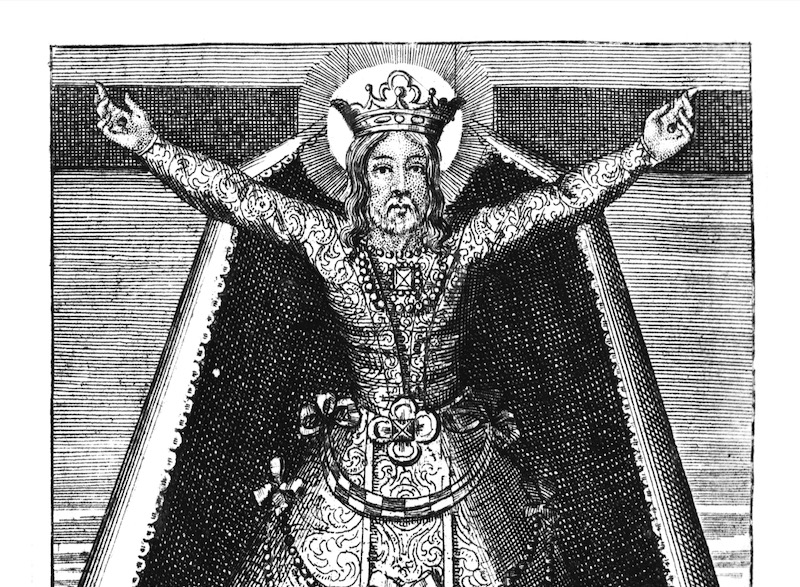Saints seem to have become a hot topic currently, but early spring is a good time for patron saints anyway. We had St David for Wales on March 1, with his leeks and daffodils. Then we have St Patrick on March 17 and one of St Joseph’s feast days on March 19. St Joseph has two feast days, one as Spouse of the Virgin and one as The Worker on May 1, though that second one has only been a feast day since 1955. I suspect it’s partly to make up for Our Lady having so many; it can’t be because we know so hugely much about him. We do know that he used to get messages from God in his dreams, though, so he is a very good person to appeal to if the pandemic is making you lie awake.
The Pope has decided to dedicate this year to St Joseph, so his days are especially important this year. St George will be coming up in April. Traditional saints are no longer as familiar to every Catholic child as they used to be. I think this is partly because we are now much more concerned about evidence and authentication and less about good stories. (Somehow this seems almost quaint, in this age of fake news and internet wacky ideas, with no evidence but many believers.) Saints’ lives are like the apocryphal Gospels, full of charming stories, like Jesus modelling little clay birds which fly away.
I think we used to accept these accounts as a sort of holy fairy story, where the rules of evidence are not the same as they would be in court. This is certainly the way they were written or told, which is why the same stories appear with different heroes, like Androcles and the Lion turning into a Christian martyr story, or later with St Jerome as the hero. The point is the message of kindness and mutual help, not what day of the week it happened. Traditional saint stories are myths and legends, rather than a newspaper, or the Dictionary of National Biography.
What are saints for? The old answer used to be that they were good examples, virtuous heroes for us all to emulate, but that doesn’t really cover it, because most saints are from so long ago, or lived in such peculiar circumstances, or behaved in ways which we would now consider pathological rather than desirable. More modern saints can come trailing clouds of historic baggage or politics rather than glory, like the Orthodox canonisation of all their royal families, or our canonisation of popes. In many ways the old legends are safer, so long as we are clear on the messages of the stories we tell.
The stories of St Francis may make an adult smile, but their message is of respect for the natural world and an awareness of our place in it. The same is true for the stories of lions and other beasts living in peace with the Desert Fathers (and Mothers). The stories are simple and memorable, like Aesop’s Fables (and some of them are similar). One of my favourites was St Zita, because when she was caught up in her thanksgiving after Communion (like a good girl), and forgot that it was time to take the bread out of the oven, some angels helpfully came and did it for her. She came home to find perfectly baked loaves lined up on the kitchen counter rather than charred little cinders.
St Elizabeth of Hungary was caught redhanded by her husband (who had tried to restrain her excessive generosity) with an apronful of food to give to the hungry, but when he insisted on her showing him what she was holding, it turned into roses and she didn’t get into trouble….and so on. St Francis and the wolf of Gubbio, St Simon Stylites and the dragon he cured of blindness curled up at the base of his pillar. There was an unfortunate cull of saints in the sixties when the Church deselected some of the saints whose details were lost in the mists of antiquity or folklore.
My mother never forgave whichever pope it was who struck off Philomela, because that was her confirmation name. We all choose a patron saint for our confirmation. It can be difficult sometimes to find good female saints, because so many of them are virgin martyrs and that’s all we know about them, slightly limiting as a modern role model, so one of my sisters opted for Peter, but the nuns made her spell it Peta. I think you’d probably be allowed to spell it as you chose nowadays.
There are a few interesting new women saints coming through, and we are learning more about some of the early historical ones, like my patrons for the website, Hildegard of Bingen and Hilda of Whitby (Hildegard wrote music, among other things; and Hilda had to deal with the Church authorities of her day). If they aren’t virgin martyrs, female saints tend to be members of religious orders, as both of these were. Lay role-models are extremely rare; female virtue has so often been below the radar or taken for granted.
Saints can seem very relatable when you can read the actual words from a person (both St Teresa and St Therese; Julian of Norwich; Mary Ward; Dorothy Day), but that’s unusual until you come into more modern times (Julian had to have a scribe to take down her dictation). There is also the problem that the Church takes so long to canonise women. I include Mary Ward because I am sure that she is a saint, but she has not yet been recognised as such by the Church because she challenged the orthodoxy of her day. Dorothy Day’s cause has apparently stalled because she had a child out of wedlock, but this didn’t stop St Augustine (and several male others).
When you have children, you get to choose names and patron saints for them. My sisters and I were all given Mary as a middle name, and we did the same with our daughters. We thought carefully about the names, about rhythm and euphony as well as saints (or Old Testament heroines, roped in because there were so few female saints). After a few years and a few children I began to wonder whether we were choosing them or they us.
One of my eldest son’s middle names is Anselm, after the great British saint. A couple of years later, another son was born on St Anselm’s day, and we thought that was a charming coincidence, almost like St Anselm accepting the compliment and paying it back. I now count him as a family friend, not just Peter’s champion.
Another saint we feel looks out for us especially is St George. We went through the usual dinosaur phase with the children, but dragons have been a much longer-lasting enthusiasm (and the distinction between the two is, after all, slightly porous). So pictures of George in galleries and churches were always something to look out for, especially after Rachel decreed that if the dragon had a chain around its neck, that proved that St George wasn’t going to kill it, he was going to take it home. As a pet. (St George’s story shows the same technique I was describing with Androcles : there is often a princess chained to a rock in the background because George’s killing of the dragon has borrowed some of its elements from Perseus and Andromeda.)
St George is familiar to us as the patron saint for England, but when we started working abroad, we discovered that George was often there already, welcoming us to our new countries. We found him in Prague, in one of the oldest churches of that most beautiful city, and also in Georgia, where the whole country is named after him (at least in English, but not in Georgian, though he is the country’s patron saint). He is the patron of an amazing number of countries and cities (I suspect the children would add ‘and we seem to have lived in most of them’). He’s also one of the saints we share with the Orthodox, ecumenically very helpful.
There are some wonderful icons of him, with gorgeous dragons (one of our favourites is patchwork). There are Turkish, Armenian, Ethiopian and Syrian accounts of St George, and we found him yet again when Mary went to live in Catalonia. I was glad he was there to watch over her. I very much like the feeling that the Communion of Saints means two-way traffic. It does not mean just our beloved dead, but we can have other friends too, like Anselm and George. It’s not just me, either: it was touching to see that Archbishop Tartaglia died on the feast of St Kentigern, his home city’s patron, as The Tablet’s obituary of 30 January noted.
I think we should not be embarrassed by our saint stories. I am sad that we have lost some of our too-few women saints, just because we don’t have chapter and verse; there must be millions of saints that we don’t know about, and no one is suggesting going through the Gospels and deleting all the parables Jesus uses to point a message, on the grounds that the Prodigal Son was not a real historical person.
I think we could usefully repurpose such saints as St Wilgefortis, or Uncumber. She is the bearded lady you sometimes see in pictures on a cross, and she is thought to have arisen out of a simple mistake. Crucifixes come in different styles; one style had Christ clothed as a priest (my younger brother was given one of these for his First Communion, I remember), with the usual beard. The more common style shows him in only a loincloth. In one place where the two styles collided, confusion arose as to who this dressed person on the cross might be.
Thus the legend of St Wilgefortis grew up, a beautiful princess who did not want to get married but her father insisted. So she prayed, and woke up with a beard the next day, which saw off the suitor. There are several saint stories along these lines, where the basic plot mechanism is a vow of virginity. It was, after all, the only way to retain a certain amount of self-determination for women.
Many widows headed into convents to protect their independence (they didn’t all take vows). Perhaps we could develop Saint Wilgefortis as a supporter of women whose voice needs to be heard. Here’s another (probably historical) one, St Werburga, daughter of the king of Mercia, who ran several convents in the Midlands. Her legend has her bringing a wild goose back to life after her steward took it from the flock and ate it, thinking she would never notice (like St Nicholas resurrecting the eaten little boys). An impressive woman, good at detail as well as wide management responsibilities. I particularly like the end of this account (in Helen Waddell’s translation of William of Malmesbury’s Gesta Pontificum in Beasts and Saints): “Most gracious is her footfall among the women and boys, who pray as it might be to a neighbour and a woman of their own countryside.” We love the saints we can relate to.
Kate Keefe composes musical settings for the Mass and writes about the psalms. You can follow her on Facebook, Twitter and LinkedIn



 Loading ...
Loading ...
What do you think?
You can post as a subscriber user ...
User comments (0)